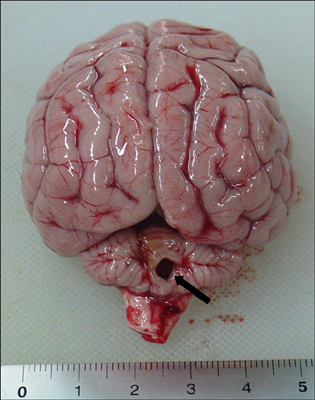J Vet Sci.
2008 Jun;9(2):215-217. 10.4142/jvs.2008.9.2.215.
Cerebellar vermian hypoplasia in a Cocker Spaniel
- Affiliations
-
- 1Department of Veterinary Surgery, College of Veterinary Medicine, Seoul National University, Seoul 151-742, Korea. ohkweon@snu.ac.kr
- 2Department of Pathology, College of Veterinary Medicine, Seoul National University, Seoul 151-742, Korea.
- 3Department of Radiology, College of Veterinary Medicine, Seoul National University, Seoul 151-742, Korea.
- KMID: 1106240
- DOI: http://doi.org/10.4142/jvs.2008.9.2.215
Abstract
- An eight-week-old female Cocker Spaniel was presented with ataxia, dysmetria and intention tremor. At 16 weeks, the clinical signs did not progress. Investigation including imaging studies of the skull and cerebrospinal fluid analysis were performed. The computed tomography revealed a cyst-like dilation at the level of the fourth ventricle associated with vermal defect in the cerebellum. After euthanasia, a cerebellar hypoplasia with vermal defect was identified on necropsy. A polymerase chain reaction amplification of cerebellar tissue revealed the absence of an in utero parvoviral infection. Therefore, the cerebellar hypoplasia in this puppy was consistent with diagnosis of primary cerebellar malformation comparable to Dandy-Walker syndrome in humans.
Keyword
MeSH Terms
Figure
Reference
-
1. DeLahunta A. Veterinary Neuroanatomy and Clinical Neurology. 1983. 2nd ed. Philadelpia: Saunders;260–262.2. Franklin RJ, Ramsey IK, McKerrell RE. An inherited neurological disorder of the St. Bernard dog characterised by unusual cerebellar cortical dysplasia. Vet Rec. 1997. 140:656–657.
Article3. Harari J, Miller D, Padgett GA, Grace J. Cerebellar agenesis in two canine littermates. J Am Vet Med Assoc. 1983. 182:622–623.4. Jeffrey M, Preece BE, Holliman A. Dandy-Walker malformation in two calves. Vet Rec. 1990. 126:499–501.5. Kornegay JN. Cerebellar vermian hypoplasia in dogs. Vet Pathol. 1986. 23:374–379.
Article6. Noureddine C, Harder R, Olby NJ, Spaulding K, Brown T. Ultrasonographic appearance of Dandy Walker-like syndrome in a Boston Terrier. Vet Radiol Ultrasound. 2004. 45:336–339.
Article7. O'Brien DP, Axlund TW. Ettinger SJ, Feldman EC, editors. Brain disease. Textbook of Veterinary Internal Medicine. 2005. Vol. 1:6th ed. Philadelpia: Saunders;820–821.8. Pass DA, Howell JM, Thompson RR. Cerebellar malformation in two dogs and a sheep. Vet Pathol. 1981. 18:405–407.
Article9. Rodney S. Simon RP, Olby NJ, editors. Tremor and involuntary movements. BSAVA Manual of Canine and Feline Neurology. 2004. 3rd ed. Cheltenham: British Small Animal Veterinary Association;190–191.10. Schatzberg SJ, Haley NJ, Barr SC, Parrish C, Steingold S, Summers BA, deLahunta A, Kornegay JN, Sharp NJ. Polymerase chain reaction (PCR) amplification of parvoviral DNA from the brains of dogs and cats with cerebellar hypoplasia. J Vet Intern Med. 2003. 17:538–544.
Article11. Summers BA, Cummings JF, DeLahunta A. Veterinary Neuropathology. 1995. St. Louis: Mosby;82–86.12. Url A, Truyen U, Rebel-Bauder B, Weissenbock H, Schmidt P. Evidence of parvovirus replication in cerebral neurons of cats. J Clin Microbiol. 2003. 41:3801–3805.
Article13. van der Merwe LL, Lane E. Diagnosis of cerebellar cortical degeneration in a Scottish terrier using magnetic resonance imaging. J Small Anim Pract. 2001. 42:409–412.
Article
- Full Text Links
- Actions
-
Cited
- CITED
-
- Close
- Share
- Similar articles
-
- Congenital Ocular Motor Apraxia with Cerebellar Vermian Hypoplasia
- Congenital Ocular Motor Apraxia: Clinico-Radiological Analyses
- Atropine-induced atrial bigeminy during general anesthesia in a Cocker Spaniel dog
- Sonographic Measurement of the Fetal Cerebellar Vermis
- Medial Trunk Aneurysm of the Distal Posterior Inferior Cerebellar Artery in the Fourth Ventricle: Case Report




